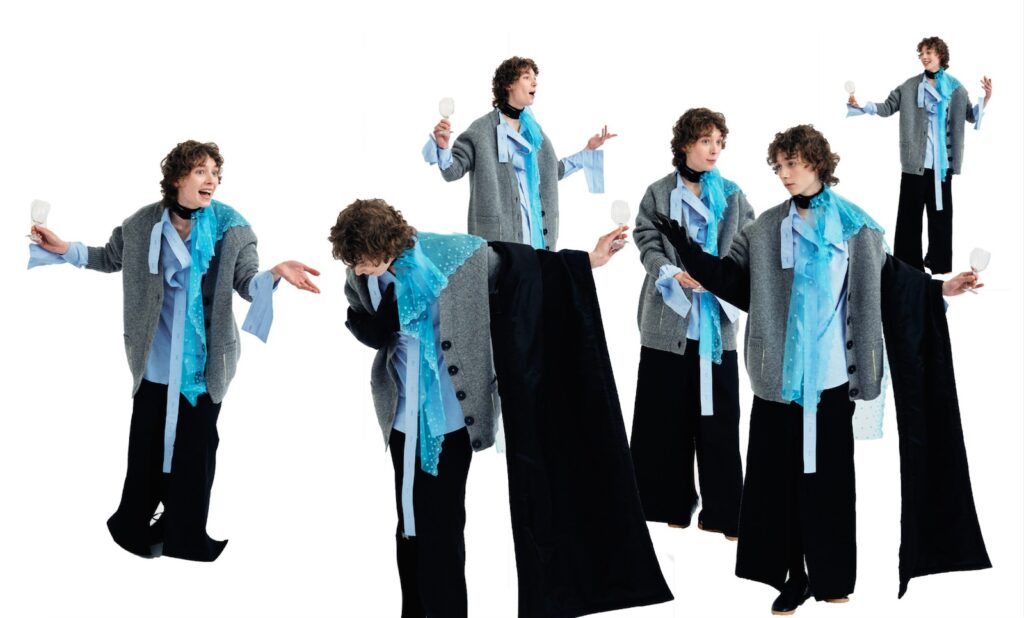A Conversation with Meryll Rogge
In Deinze, just outside Ghent, Belgium, Meryll Rogge is relatively calm and collected, speaking about Fall-Winter 2022. Less than a week away, she is finalising details for her debut on the official Paris Fashion Week® schedule. Her unflustered demeanour can be attributed to a certain ambivalence about artful inspirations, esoteric references, even gender boundaries – all resonating across her new collection. Simply, Rogge is here to make good clothes. It’s not intended to change the game, but it feels like a game-changing proposition, one that is inherently respectful of fabric, silhouette, and deft pattern-cutting.
Titled ‘Poor Connection,’ Rogge’s collection is a study in how the pandemic has upended wardrobe conventions. If football jerseys are rendered in vivid pink, royal blue, synthetic colours, she also proposes counterparts in a more muted colour scheme spanning grey melange, beige, and washed black that resembles classic men’s suiting. Notably, there’s some tailoring too – and this interest in menswear shapes reflects her desire to make unisex clothing. It appears alongside grey melange coating, double-faced Shetland wool coats with cashmere lining, cotton shirting, and the more glamorous looks in luscious silk, charmeuse, and lurex faille. The resulting collection is an encyclopedic journey of textural indulgence.
“The important thing is to make clothing that appeals to people rather than really focusing on ‘proper’ inspiration,” Rogge shared.

What was your inspiration?
It changes every season. There are seasons where we don’t want to look at anything like [film, music art, photography]. Literal reference pulling like “this season we looked at this art and this is our connection” is not something we do. It’s more about portraying an image that suits the brand. For the moment, we keep it more abstract. I mean, of course, we’ve looked at the Cindy Sherman, vintage fashion, things we’ve found on Etsy. It’s a mishmash.
How did you arrive at the title ‘Poor Connection’?
It’s a human thing responding to how we’re having trouble creating these connections at the moment. It’s also about the disconnect in our wardrobes. There are no more boundaries between things and things are borrowed and reinterpreted in different ways. Before, it was way more about categories of garments and wearing certain things at certain times of day and that was it. I feel like these boundaries are really fading and anything goes – in a very positive way. There’s no more connection to its original source; you can absolutely put things into a different context and just make something new appear.
How do you balance familiar ideas with new conventions?
We always want to push things forward a little bit, or at least in our own way. We’re not under any pretensions that we’re doing anything new, because I don’t think there is anything new. Everything has been done. It’s a complex thing, because there’s this new generation of people who were born in 2004 and have just discovered the ’90s. It’s not new, but for them it is. Basically, what we’re trying to do is create an image that is honest and suits us. It’s done by combining familiarities in a way that we find interesting.
To what extent do you think that fashion is about proposing dreams?
I don’t really think about it that much. It’s really hard to explain the amount of work that goes into a collection, the amount of sacrifices; I guess it is about creating this dreamlike image. As a spectator of fashion, and as a fan, this happens rarely, but when you see a great collection, you can get this feeling of euphoria or joy. I feel this when I see a collection that I really enjoy; so, to that extent, there is a dream factor. It’s easier for me to speak about it from a spectator’s point of view than as a fashion designer.
Do dreams help us make sense of reality or do they act as an escape?
They’re an escape. In fashion, it’s weird because you’re often talking about reality, tangible things, and an image of today; but sometimes, what you see on the runway is not what you might see on the streets.
What is a dream you’d like to achieve this year?
I would love for us to win the LVMH Prize. It would be great. All help is welcome from mentoring to financing; the whole thing would be wonderful. Of course, we’re not counting on it but that would be great. A nice, tangible dream.
This interview has been lightly edited for clarity.



